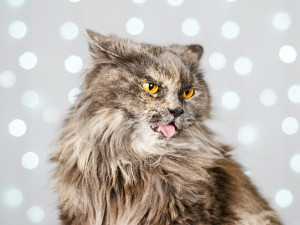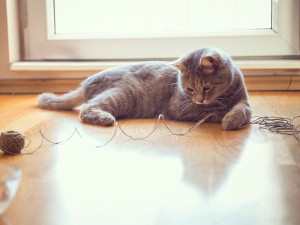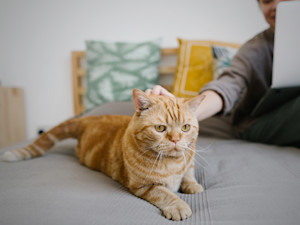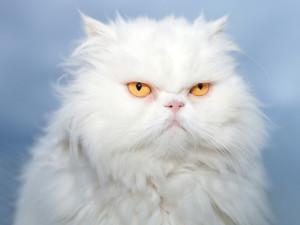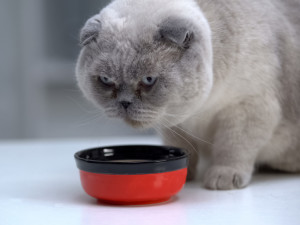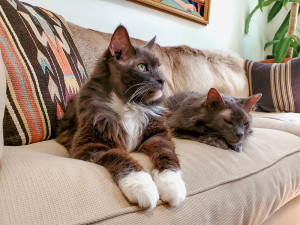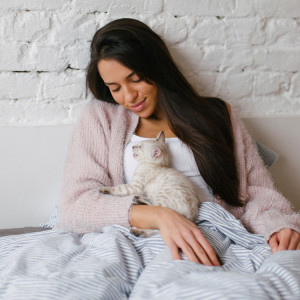Kidney Disease in Cats: Symptoms, Signs, and Treatments
If you notice some of these issues, it’s probably time to talk to your vet.
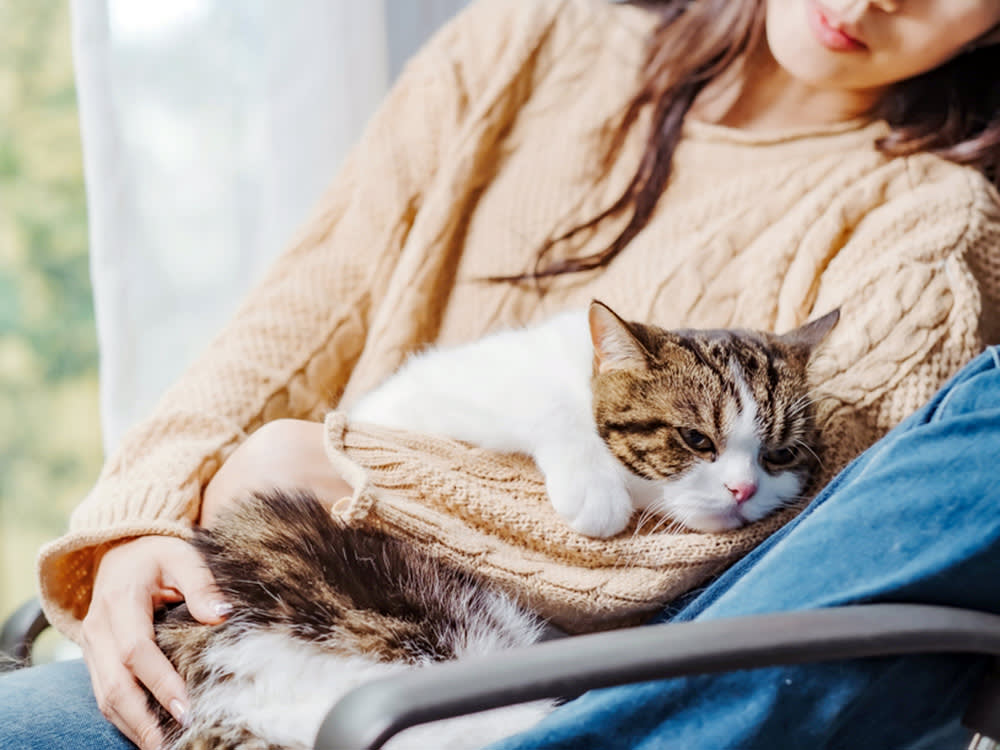
Share Article
In This Article:
What Is Kidney Disease in Cats? Symptoms of Kidney Disease in Cats Causes of Kidney Disease in Cats Diagnostic Testing Treatments for Kidney Disease When to Consider Euthanasia Frequently Asked Questions
If your cat is reaching their golden years, you’ll probably hear about kidney disease. It’s a very common condition as cats age. So, what’s a cat parent to do? We’ll help you recognize the signs of kidney disease and discuss some treatments, even though kidney disease cannot be cured. Rather, it’s important to manage it. Here’s how.
What is kidney disease in cats?
A cat’s kidneys have many important roles in maintaining a cat’s health, including:

Filtering waste from the blood
Maintaining water and electrolyte balance in the body
Regulating blood pressure
Stimulating red blood cell production
As cats age, their kidney function can naturally decline, leading to chronic kidney disease (CKD). While CKD is more common in senior cats, it can also affect younger cats due to congenital or acquired causes.
Symptoms of kidney disease in cats
The signs of kidney disease in cats can vary depending on the severity of the disease, but they tend to be nonspecific. Common symptoms include:
Increased urination (polyuria)
Increased thirst (polydipsia)
Poor appetite
Weight loss
Lethargy
Bad breath
Abdominal pain
Poor coat quality
Causes of kidney disease in cats
Cat parents worrying about their sick kitty may wonder what causes kidney disease in cats. Kidney disease can be divided into two groups: acute and chronic. Acute kidney disease can result from a sudden injury to the kidneys. Possible causes of acute kidney disease include infection, toxins (like lilies or antifreeze), and urinary obstructions. Kidneys can often recover from acute injury with prompt treatment, but that is not always the case. Acute kidney disease can sometimes lead to chronic kidney disease.
Chronic kidney disease can be divided into two groups: acquired and congenital. Acute kidney injury can lead to CKD if the kidneys don’t fully recover. Other acquired causes include viral infections (like feline infectious peritonitis), some medications, and chronically high blood pressure. The degeneration of kidney function that often comes with old age is also considered an acquired cause of CKD.
Congenital causes of CKD occur during fetal development and impact kidney function at some point in a cat’s life. One of the most common congenital causes of CKD in cats is polycystic kidney disease. Polycystic kidney disease in cats is a genetic disease that results in the development of multiple cysts (pockets of fluid) in the kidneys. The number and size of cysts vary by cat, but the cysts slowly grow and eventually replace normal kidney tissue, leading to kidney failure. Polycystic kidney disease is most commonly diagnosed in Persian cats.
Diagnostic testing for kidney disease in cats
So, you’re noticing that something’s off with your older kitty. How exactly does a vet get to the bottom of it, bringing up kidney disease as the diagnosis? They will rely on various tests that check the kidneys’ function. Those include blood work and a urinalysis and potentially imaging and blood pressure readings.
Blood work
The kidneys filter waste products from the blood, so it would make sense that their decreased function would cause an increase in these waste products. That’s exactly what blood work measures. These are the most notable waste products analyzed for kidney disease.
Blood urea nitrogen (BUN): This is a waste product of protein breakdown that is eliminated by the kidneys.
Creatinine: This is a waste product from the breakdown of protein and muscle tissue.
SDMA: This is considered a sensitive, early marker for detecting a decrease in kidney function.
These are other important values for kidney function that can be revealed by blood work.
Phosphorus: This is important for maintaining calcium levels and cell structure in the body. Phosphorus levels often increase as kidney function declines.
Electrolytes (sodium, chloride, potassium): Kidney disease can cause an imbalance of fluid and electrolytes, which can impact other bodily functions.
Red blood cell count: Erythropoietin, a hormone secreted by the kidneys, stimulates RBC production. Poor kidney function can lead to anemia.
Urinalysis
What better way to assess kidney function than by looking at the end product that they produce? Here are a few urinalysis values that are of special importance.
Urine specific gravity (USG): This indicates how concentrated or dilute urine is. Well-functioning kidneys should be able to conserve water and adequately concentrate urine, while kidneys in failure will produce large amounts of very dilute urine.
Urine sediment: Microscopic inspection will look for bacteria, crystals, or abnormal cells in the urine.
Urine protein to creatinine ratio (UPC): This indicates how much protein is leaking into the urine.
Urine culture
Urine culture checks for the presence and type of bacteria in the urine, which could indicate a urinary tract infection.
Blood pressure measurement
High blood pressure can be a complication of kidney disease and can further damage the kidneys.
Imaging
Radiographs can help assess the size and shape of the kidneys as well as identify stones in the urinary tract. Meanwhile, ultrasounds will provide more detailed views of the kidneys and can help detect abnormal structures like cysts or tumors.
Treatments for kidney disease
Chronic kidney disease is a progressive condition with no cure. Treatment is aimed at managing the signs and slowing its progression, so your cat feels better for longer. Treating kidney disease in cats involves a combination of hydration, dietary management, and medications.
Ensure adequate hydration
In early kidney disease, maintaining hydration includes strategies to encourage voluntary water consumption, like providing a cat water fountain. Some cats require intermittent or routine subcutaneous fluids to provide a hydration boost. Cats with severe dehydration often require hospitalization for intravenous fluids.
Make dietary adjustments
Prescription kidney diets are formulated to restrict protein and phosphorus, which helps reduce the kidneys’ workload. Not all cats are fans of therapeutic diets and will quickly turn their noses up at special food, so gradual diet changes are recommended.
Give recommended medications
Cats with kidney disease may develop issues that require various (long- and short-term) medications, including:
Antibiotics for urinary tract infection
Blood pressure medication
Anti-nausea medication
Appetite stimulants
Phosphorus binders
Monitor closely
Cats with kidney disease require frequent checkups for lab work and blood pressure monitoring. This allows your vet to determine if your cat needs a treatment change. Cat parents should also keep a watchful eye on litter box habits, as well as food and water intake at home.
Seek aggressive care when needed
As kidney disease progresses — and it will — there may be a time when your vet recommends more aggressive treatments. Anorexia, vomiting, pain, weakness, or sudden blindness are all signs that more needs to be done in a hurry. Hospitalization might be required for procedures such as blood transfusions or aggressive supportive care. Dialysis and kidney transplants have been performed in cats, but these treatments are not commonly pursued because of the expense, equipment, expertise, and risks involved.
When to consider euthanasia
Making an end-of-life decision for a beloved kitty with kidney disease can be challenging. Even with ideal care, chronic kidney disease will progress to a point where the symptoms are severe, response to treatment is inadequate, and the overall quality of life diminishes. Some cats become so ill that it's clear that euthanasia will spare them from suffering more. But for those cats experiencing a mix of good and bad days (though leaning more towards bad), the decision-making process may take some time and consideration.
For a more objective approach, pet parents can use the quality of life scale, like the HHHHHMM Scaleopens in new tab. The letters stand for Hurt, Hunger, Hydration, Hygiene, Happiness, Mobility, and “More good days than bad days.” These factors are used to assign a score to a pet’s quality of life. Another resource is Lap of Love’s Quality of Life Assessmentopens in new tab website.
When to euthanize a cat with kidney disease is a decision to be made thoughtfully, and your veterinarian can help guide you through it.
Bottom line
Kidney disease is a common condition that affects cats mainly as they age. It can lead to symptoms such as increased thirst, increased urine production, nausea, vomiting, weight loss, and bad breath.
Rather than curing kidney disease, your vet will work to manage symptoms to help your cat feel as good as they can, for as long as they can.
FAQs
What is polycystic kidney disease in cats?
Polycystic kidney disease in cats is a genetic condition that results in the development of multiple cysts (pockets of fluid) in the kidneys. The cysts slowly replace normal kidney tissue, eventually leading to kidney failure.
How long can cats live with kidney disease?
Cats can live many years with chronic kidney disease. A cat’s life expectancy varies greatly, depending on how early the kidney disease has been diagnosed, how a cat has responded to treatment, and complications that may have developed along the way.
What are the stages of kidney disease in cats?
The International Renal Interest Society (IRIS) breaks down chronic kidney disease into four stages. Cats with Stage 1 CKD have mild disease with no symptoms, while cats with Stage 4 CKD may require hospitalization for intensive care. Of course, stages 2 and 3 fall somewhere in between.

Dr. Chyrle Bonk, DVM
Dr. Chyrle Bonk has been a mixed-animal veterinarian since 2010, with a special interest in rehabilitation. When she's not practicing or writing about veterinary medicine, you may find her exploring the outdoors with her family or tending to her cows, horses, chickens, or cats and dogs.

Dr. Alycia Washington, DVM, MS
Alycia Washington is a small-animal emergency veterinarian with over 10 years of experience based in North Carolina. She works as a relief veterinarianopens in new tab and provides services to numerous emergency and specialty hospitals. She also works as a veterinary writer with a focus on educating pet parents.
Related articles
![Cat eating out of a red bowl]()
Does Your Diabetic Cat Need a Special Diet?
Get ready for a sigh of relief — this food doesn’t have to be pricey.
![A senior cat is held in their owner's lap]()
How to Care for Your Senior Cat
From taking them to the vet more often to giving them a hand with grooming, older kitties need a little extra TLC.
![Two senior cats laying on a couch]()
Why Senior Cats Make the Best Roommates
Kitten, please! I adopted a couple of seniors because cats, like wine, only get better with age.
![cat coming out of litter box]()
What to Do When Your Cat Refuses to Be (Litter) Boxed In
An expert explains why kitties are so particular about where they pop a squat.
![Young beautiful woman cuddling with little snow bengal kitten on the bed.]()
15 Terms You Should Know When Choosing a Pet Insurance Plan
Overwhelmed by all the small print and jargon? We’ve got you.
![A woman in a bright yellow-orange sweater holding a striped kitten in one hand and a credit card in the other while using her laptop in front of her]()
How to Get Help With Vet Bills for Dogs Who Need Surgery
Worried about the cost of making your pet feel better? Help is on the way.

